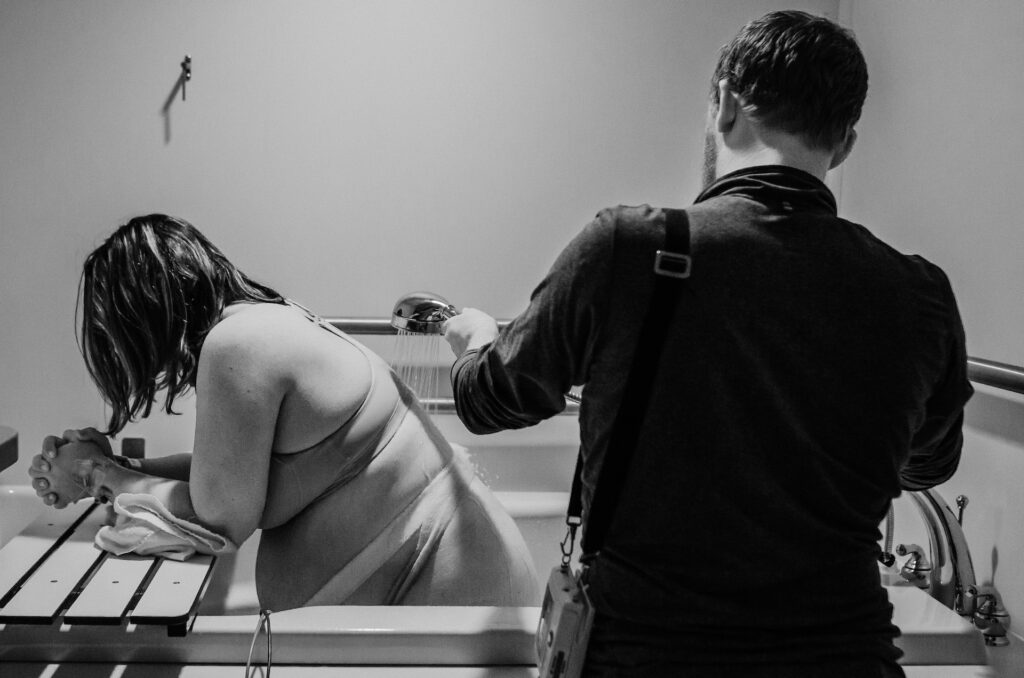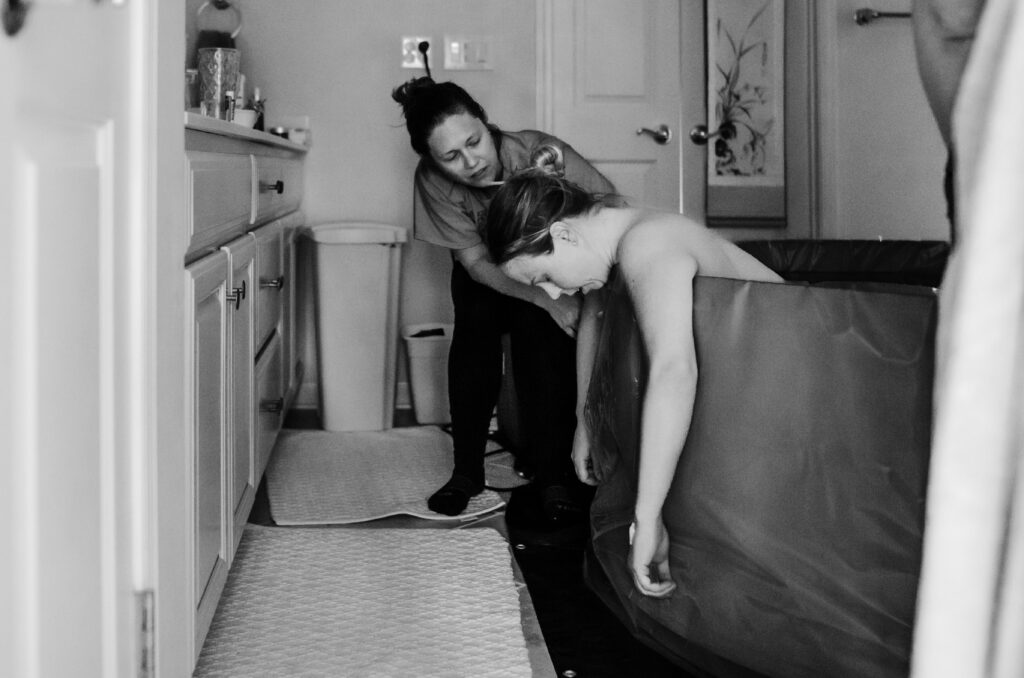Is there someone special in your life who is expecting a baby? Congratulations! If you are at their birth, you will want to know how to be a supportive labour and birth partner! Having labour and birth support is impactful on a mother’s overall satisfaction. At times, it can reduce unwanted interventions. Many women can recall meaningful things a supportive person did for them in labour and birth. Here are ten incredible ways to be a supportive labour and birth partner for your loved one during this challenging, vulnerable, and life-changing experience.
1. Educate yourself In Advance
You may not know much about labour and birth. If you are reading this article right now, you’re already on track to learning more. There are many resources to learn about labour and birth, including but not limited to-
- Information from your healthcare providers (doctor, nurses, midwife, OB)
- Doulas
- Childbirth education classes
- Online resources such as articles and video content
- Discussions with others who have been through labour and childbirth (though each experience is individual)
- Books purchased online, in stores or borrowed from a library
All of these resources will provide you with insight into things like labour coping mechanisms, what to bring to the hospital, what labour progress may look like, what pain control options will be available to you, when to go to the hospital, etc. If you are unsure about anything important, your healthcare provider is the best person to ask.
2. Learn to time contractions
Before getting into detail here, know that every labour and birth is different and if you are concerned or unsure, contact your provider/facility. Timing contractions is helpful in knowing when true labour is starting and progressing. When timing contractions, it is important to count from the start of one contraction to the start of the next to determine how far apart they are. Do not time the interval from the end of one contraction to the start of the next, you may go to your care provider too soon. There is a rule called the 4-1-1 rule, which means that contractions are every 4 minutes, for 1 hour or greater and are lasting 1 minute (or greater). This may be an indication that you are in true labour. If you are not at this point yet but they are strong enough that you cannot be distracted by them or unable to get any relief with at-home coping mechanisms, you may want to head into your birthing facility. There are some circumstances and conditions which constitute early admission, determined by your provider. If you live far from your birthing facility, you may need to go sooner. Even if you are close, but you have had a previous delivery that progressed quickly, you may need to head in sooner as well. Remember, these are just rough guidelines and you should always follow recommendations from your healthcare provider.
3. Be present
This one may be the easiest but most IMPORTANT step. This person chose you as a support person for a reason. They want you to be a part of things. Ignoring their pain and snoring in the corner is not part of labour and birth. They did not ask you to come scroll on your phone or complain that you’re tired or bored. Women want active support, meaning being present, attentive and aware of what’s going on. Nurses and other HCPs do their best to support the woman, but due to extensive tasks and charting responsibilities on one or more patients, they sometimes cannot provide the constant 1:1 care that the mom deserves. If labour is long, you may choose to take small breaks, rest if mom is resting or swap out with other support people. You need to take care of yourself too, but ultimately the mother’s needs should be a priority.
4. Be physically supportive
It can be hard to get comfortable, bear one’s own weight and change position when experiencing pain. You can ease the labouring and birthing person’s workload by physically helping them.
This can mean:
- Holding their leg up when they are pushing or feeling a lot of pressure.
- Giving gentle back or shoulder rubs.
- Allowing the labouring person to lean on you during contractions.
- Helping with position changes (ex. changing from labouring or pushing on their back to hands and knees).
- Spraying or pouring warm water down their back in the tub/shower.
- Allowing them to hold and/or squeeze your hand(s) for comfort or during pain.
- Performing counterpressure if back pain is present. The labouring person should lean over a bed or birthing ball. Place one hand under the hip for support and use the heel of your hand to put hard, steady pressure on the lower back or buttocks during contractions. Do not release it until the contraction is over. You may have to try a few different areas to see what feels best to the labouring person.

5. Offer water and/or a cool cloth
Labour is exhausting, painful and requires focus. The labouring person may not think to ask for a drink. However, they will be thankful you asked. Have cold water available and offer sips periodically. In early labour, light snacks may be allowed and wanted by the labouring person. If her ice water is empty, know where to get a refill and do it without being asked. You can also offer a cold face cloth – keep it cold and hold it on them or just wipe their forehead and neck. Especially during pushing, mom can get overheated fast! She will be focused on simply getting through labour and birth. Water to drink and applying cool facecloths are simple offerings that go a long way.
6. Give positive verbal praise
We all need a cheerleader sometimes. Match the energy of the birthing person. If they are loud, maybe you can be a bit louder with your encouragement. If they are quieter going through the experience, express quiet, calm encouragement. Often women will reach a point where they say “I CAN’T DO THIS.” A reply to this is “you ARE doing it.” Other affirmations you can say:
- Every contraction is bringing you closer to the baby.
- You are amazing.
- I am so proud of you.
- You are doing everything right.
- Just like that!
- You can do this. You are doing it.
- Great breathing/pushing.
- This is not going to last forever. Babies always come.
- One contraction at a time.
We all need a cheerleader sometimes. Match the energy of the birthing person. If they are loud, maybe you can be a bit louder with your encouragement. If they are quieter going through the experience, express quiet, calm encouragement. Often women will reach a point where they say “I CAN’T DO THIS.” A reply to this is “you ARE doing it.” Other affirmations you can say:
- Every contraction is bringing you closer to the baby.
- You are amazing.
- I am so proud of you.
- You are doing everything right.
- Just like that!
- You can do this. You are doing it.
- Great breathing/pushing.
- This is not going to last forever. Babies always come.
- One contraction at a time.
Birth is not only about making babies. Birth is about making mothers ~ strong, competent, capable mothers who trust themselves and know their inner strength
Barbara Katz Rothman Tweet
7. Encourage rhythmic breathing
Breathing is key during labour and delivery. If a woman loses her breath or begins to hyperventilate, they might need reminders to slow their breathing. Hyperventilating will ultimately tire the labouring person out and they’ll push less effectively. Breathe with them if this is something that helps them. In- out, in-out.
8. Stay calm
If you are panicking, the labouring person can usually sense this too and feel unassured. If you are agreeing to support someone through one of the most important experiences of their life, it is key that you are able to control your feelings and reactions. A calming presence is what the labouring and birthing person needs. If you panic around people who are in pain or get squeamish around bodily fluids recognize that someone else may be a better choice for the role of labour support. At most facilities, you can still be at your partner’s side even with another individual present taking the reins on support. There are times when birth plans change or when babies are born and require extra stimulation or assistance with medical devices to help them transition to outside life. Try not to panic if this is the case.
9. Do not hold your own expectations
Remember that this is about them, not you. Do not complain or expect praise or thanks for your role. The person may choose to thank you throughout this experience – but they also may not. Women in labour are exhausted, in pain and sometimes fearful of the impending birth. Their job is to get through labour, not praise you right now. They may say or do things that are out of character. It is important to not take this personally. Many people say things they don’t mean in labour and some apologize later. Every person also experiences and copes with pain differently, or has labour and deliveries with different outcomes than expected, sometimes for no clear reason. Avoid comparison to yourself or others when the labouring/birthing person is making decisions for her care. Do not say things like, “I thought you wanted to do this without pain medication,” or “When I had my babies I only pushed for 45 minutes,” or “you got an epidural last time, why don’t you do that again so you can relax more.” These statements are not supporting the person and their current experience. It is an honour to be part of such a wonderful, life-changing experience in this person’s life and you should do it without expectations of your own!
10. Let mom enjoy her baby first
Do not ask to hold the baby right away. There is nothing sadder than seeing visitors take away a mom’s baby right after it is born. It is great that you are excited to meet this new human but don’t forget about moms feelings. Not only has she been waiting as long as you (usually longer if she didn’t tell people right away) to meet the baby, but she also put in all the work of growing and birthing this baby. Give mom the opportunity to have “golden hour.” Golden hour is the first hour after birth where skin-to-skin contact between mom and baby is encouraged to optimize bonding and is beneficial to the initiation of breastfeeding. I have seen family/friends ask moms if they can hold the baby while the doctor is still repairing things down below. For goodness’ sake, wait until mom offers! You loved mom first, so don’t ignore her when she brings a cute baby into the world. Ask her how she’s feeling if she needs anything and congratulate and praise her. If you are a significant enough presence in this family’s life to be there during the birth, you should have plenty of time to bond with the baby after the first hour.
Are you ready to be supportive?
I hope that these tools boost your confidence. Every women deserves a supportive labour and birth partner. Best of luck on this journey!


